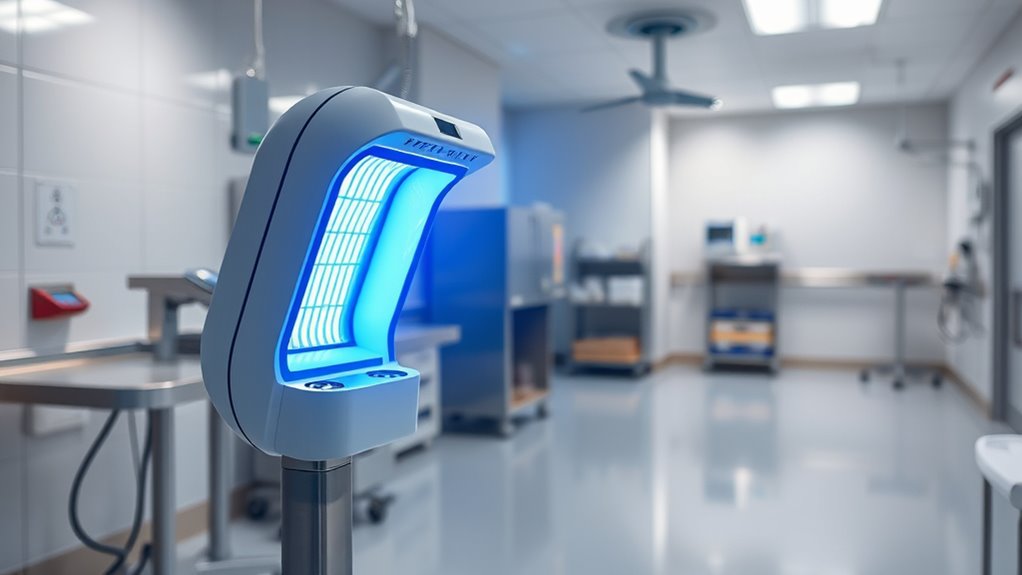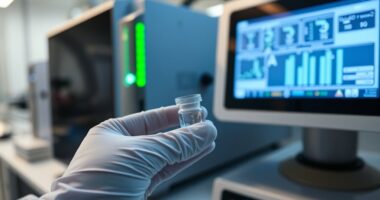To effectively implement UV-C disinfection in healthcare facilities, you need a combination of proper air circulation systems and well-trained staff. Good air flow guarantees UV-C light reaches all surfaces and airborne pathogens, enhancing disinfection. Staff must understand how to operate UV-C devices safely and maintain the ventilation systems properly. When these elements work together, you create a safer environment to reduce infections. Keep exploring to discover how to optimize these strategies for your facility.
Key Takeaways
- UV-C disinfection effectively neutralizes pathogens when combined with well-maintained air circulation systems.
- Proper staff training ensures safe operation and optimal use of UV-C devices for infection control.
- Integration of UV-C technology with ventilation prevents germ-laden air from lingering in healthcare environments.
- Regular maintenance and staff vigilance optimize UV-C disinfection outcomes.
- Combining air circulation strategies with staff practices enhances overall safety and reduces healthcare-associated infections.

Have you ever wondered how healthcare facilities keep germs at bay and guarantee patient safety? One essential aspect often overlooked is how they manage air circulation and staff training to support infection control. Proper air circulation isn’t just about keeping the environment comfortable; it plays a critical role in minimizing airborne pathogens. Healthcare settings typically utilize advanced ventilation systems designed to filter and exchange air regularly, reducing the concentration of potential contaminants. These systems often incorporate HEPA filters and negative pressure rooms, ensuring that contaminated air doesn’t spread to other areas. When combined with UV-C disinfection, this approach becomes even more effective. UV-C light can neutralize bacteria and viruses present in the air or settled on surfaces, but its success heavily depends on how well the air is circulated. Efficient air circulation ensures that UV-C-treated air reaches all corners of the room, preventing germs from lingering in dead zones. It’s a synergy that enhances overall infection control measures.
But none of this works without proper staff training. Healthcare workers are on the front lines, and their understanding of how UV-C disinfection works, along with air circulation protocols, is essential. Staff training involves teaching personnel how to operate UV-C devices safely, recognize the right settings, and understand the importance of maintaining airflow systems. It also covers best practices for cleaning, disinfecting, and handling equipment, ensuring that UV-C technology is integrated seamlessly into daily routines. Well-trained staff can identify areas where air circulation might be compromised or where UV-C devices need maintenance, preventing potential lapses in infection control. Regular training sessions keep everyone updated on new protocols, safety measures, and emerging technologies, reinforcing a culture of safety and vigilance. Additionally, adopting data-driven strategies can optimize the overall effectiveness of infection prevention efforts.
In essence, keeping healthcare environments safe isn’t just about installing UV-C lights; it’s a comprehensive effort that hinges on robust air circulation systems and well-trained staff. When air flows properly and personnel are knowledgeable, UV-C disinfection can reach its full potential, drastically reducing the presence of harmful pathogens. The combination of these elements creates a layered defense, protecting both patients and staff from infections. In a setting where every second counts, understanding and implementing these strategies ensures that healthcare facilities remain safe, clean, and ready to provide top-quality care. Proper air circulation and staff training form the backbone of effective disinfection protocols, making the integration of UV-C technology a powerful tool in the ongoing fight against healthcare-associated infections.
Frequently Asked Questions
What Safety Precautions Should Staff Follow During UV-C Disinfection?
You should always wear appropriate personal protective equipment, like gloves and safety goggles, to safeguard your skin and eyes from UV-C exposure. Make sure you’re well-trained on UV-C safety protocols before starting disinfection procedures. During operation, avoid direct exposure to the UV-C light, and ensure warning signs are in place to alert others. Properly follow staff training and safety guidelines to minimize health risks and ensure effective disinfection.
How Does UV-C Technology Impact Overall Infection Rates in Hospitals?
You see UV-C technology considerably reduces pathogens, which enhances infection control efforts in hospitals. By effectively targeting and destroying bacteria, viruses, and fungi, it leads to lower infection rates. When you implement UV-C disinfection properly, you improve patient safety and curb the spread of infections. This technology’s pathogen reduction capabilities make it a valuable tool in maintaining a cleaner, safer healthcare environment, ultimately decreasing hospital-acquired infections.
Can UV-C Disinfection Replace Traditional Cleaning Methods Entirely?
You can’t rely solely on UV-C disinfection to replace traditional cleaning methods because while UV-C efficacy is high for sterilizing surfaces and air, it doesn’t remove dirt or organic matter. Additionally, UV-C devices have a limited environmental impact compared to chemical disinfectants, but they can’t reach every surface or replace manual cleaning entirely. Combining UV-C with traditional methods ensures thorough disinfection, minimizing infection risks effectively.
What Are the Maintenance Requirements for UV-C Disinfection Equipment?
You need to regularly maintain your UV-C disinfection equipment by calibrating it to guarantee peak performance. Keep track of bulb lifespan and replace bulbs as recommended by the manufacturer, typically every 9-12 months. Clean the equipment surfaces to prevent dust buildup, and inspect for any damage. Proper maintenance ensures effective disinfection, prolongs equipment life, and keeps your healthcare environment safe.
Are There Any Limitations to Using UV-C in Certain Healthcare Environments?
Ever wondered if UV-C can reach every surface? Yes, limitations exist, especially in complex environments with shadows or uneven surfaces. UV-C efficacy drops if surfaces aren’t directly exposed, and some materials may be incompatible or degrade under UV light. You should evaluate surface compatibility and consider the environment’s layout to ensure effective disinfection, knowing that UV-C isn’t a one-size-fits-all solution.
Conclusion
By now, you see how UV-C disinfection can be a game-changer in healthcare. It’s like having a silent guardian, quietly working behind the scenes to keep patients and staff safe. Embracing this technology isn’t just smart — it’s essential in the battle against germs. So, why not harness the power of UV-C and turn your healthcare facility into a fortress of cleanliness? After all, a healthier environment starts with smart choices.









